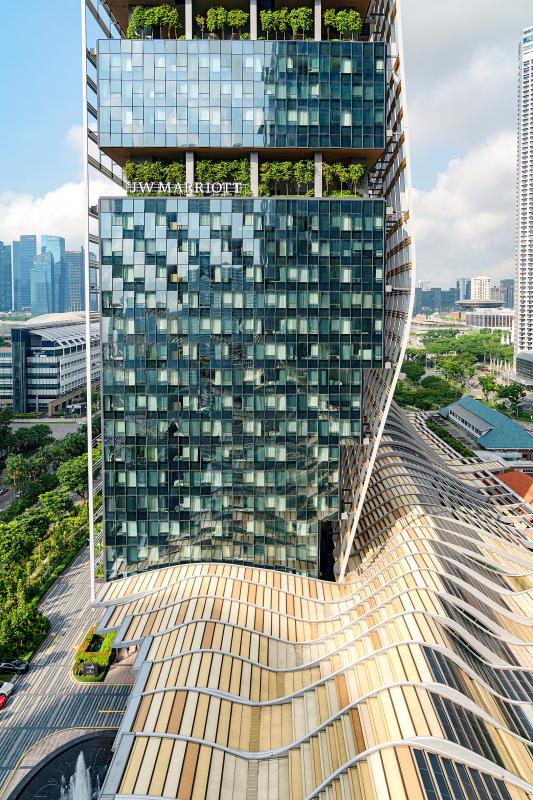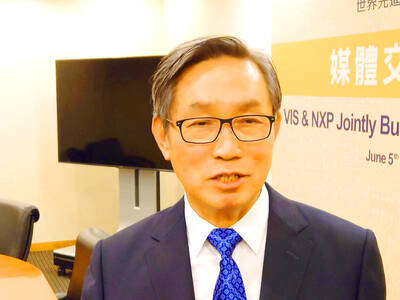On a typically hot and humid afternoon in Singapore, a fresh breeze blows beneath the canopy of the South Beach development, keeping temperatures several degrees cooler than on the surrounding streets.
The rippling 280m wave of steel-and-aluminum runs the length of the Norman Foster-designed complex, funneling prevailing winds over outdoor patrons of restaurants and bars and saving on air conditioning for the mixed-use complex. The canopy is covered with solar panels and catches rainwater to irrigate the gardens.
Offices and apartment blocks designed to be green are springing up all over the world as architects reverse almost a century of trying to insulate workers from nature and instead try to adapt structures to their natural surroundings. The change is being driven by stricter building codes, a desire to cut energy costs and, in particular, demands from corporations and start-ups that need to show shareholders and customers they are meeting environmental standards.

Photo: Bloomberg
“There’s a growing shift toward including the green credentials of a building within what constitutes competitive advantage for a developer,” said Gabriel Wilson-Otto, global head of sustainability research at BNP Paribas Asset Management in Hong Kong.
Regulators are also driving change because energy-efficient buildings are “very effective” at decarbonizing cities, he said.
Commercial and residential buildings account for about 12 percent of greenhouse gas emissions globally, the European Environment Agency has said.

Photo: Bloomberg
A review of 70 studies by researchers at Finland’s Aalto University showed that green building cuts operating expenses, raises rental income and increases the capital value of properties.
However, the tropics present a unique set of challenges and opportunities for architects, from heat and humidity to intense downpours, and in some areas, violent storms. Solving those issues is critical to reining in global warming.
By 2050, the Paris Agreement deadline for the world to become carbon neutral, half the world’s population would live in the tropical belt, up from 40 percent now.
“Buildings in Asia often account for a higher percentage of greenhouse gas emissions than the worldwide average,” said Philippe Delorme, executive vice president for energy management at Schneider Electric SE.
Singapore, just one degree north of the equator, has seen a plethora of green buildings since the government launched its voluntary Green Mark Certification Scheme in 2005. South Beach, built by City Developments Ltd, is rated platinum under the system, meaning it can achieve more than 30 percent energy savings compared with a traditional building.
“Energy efficiency is a no-brainer in a tropical city like Singapore. Green building helps bring back return on investment,” said Esther An, chief sustainability officer at City Developments, ranked as Asia’s most sustainable property developer this year by Corporate Knights Inc.
However, cost saving are not the only driver. Developers are facing increasing demand from companies and start-ups that want to burnish their green credentials. Those looking for the highest certifications include multi-nationals that need to report environmental, social and corporate governance standards to shareholders and data centers keen to cut operating costs, said Tim Lo, head of system development at BEAM Society, a certification system in Hong Kong.
“Shopping centers, large or small, are also jumping on the bandwagon for green buildings, because the shoppers want a healthier space,” Lo said.
In Hong Kong, office buildings with the highest credentials get a 37 percent premium in rent compared with non-green rated buildings, said Roddy Allan, chief research officer for Asia Pacific at Jones Lang LaSalle.
Meeting the highest standards involves a lot more than adding solar panels. Using cement and materials that generate less carbon dioxide during production, vegetation and geometry that deflects the sun’s rays are among dozens of technologies employed to reduce the carbon footprint and running costs of a structure. To attract top-end tenants, companies often employ world-renowned architects to ensure buildings also offer status as well as sustainability.
For tropical cities, a key metric is to build structures that not only look cool, but are cool. As the global temperature rises, keeping the heat down in the tropics has inspired a number of innovative technologies, from Rio de Janeiro’s Museum of Tomorrow, which utilizes cold water from the bottom of neighboring Guanabara Bay, to the hanging gardens of Singapore’s ParkRoyal hotel and the angled shading of the Suruhanjaya Tenaga Diamond Building in Malaysia.
The need to integrate those new systems into buildings is prompting tie-ups and mergers between technology firms, construction companies and city governments. One trend especially popular in big Chinese cities such as Beijing and Shanghai, is to integrate solar panels into the fabric of new buildings.
Sustainable developments offer property companies another increasingly important resource — a bigger financing pool. Real estate has been a driving force in the fast-expanding debt market, with Fannie Mae in the US one of the biggest issuers. City Developments issued Singapore’s first green note in 2017, while CapitaLand Ltd followed last year.
For many tenants and builders, the main obstacle is the initial construction cost.
In the 2018 World Green Building Trends survey, almost half the respondents cited cost as the top obstacle, followed by lack of political support or incentives, a lack of public awareness and a perception that green construction is only for high-end projects.
In Southeast Asia, the number of green-certified buildings rose rapidly in the early 2000s, but then dropped off sharply after the 2007-2008 global financial crisis, Delorme said.
“While we are seeing more Asian developers building energy-efficient buildings, progress remains slow,” he said.
Instead, many firms have resorted to upgrading older buildings. Retrofitting systems could cut energy costs by 15 percent to 35 percent depending on the level of investment, a study by the Urban Land Institute and others showed.
Yet as regulations become tougher and more tenants demand the highest levels of environmental construction, greenfield developments would increasingly need to become green developments.
“There’s a clear environmental benefit to building green but investing in green building also means significant operating cost savings, shorter payback periods and an overall increase in the value of these assets,” said Melissa Baker, senior vice president of LEED technical development at the US Green Building Council. “Developers that are not building green may find themselves at a disadvantage.”

TAKING STOCK: A Taiwanese cookware firm in Vietnam urged customers to assess inventory or place orders early so shipments can reach the US while tariffs are paused Taiwanese businesses in Vietnam are exploring alternatives after the White House imposed a 46 percent import duty on Vietnamese goods, following US President Donald Trump’s announcement of “reciprocal” tariffs on the US’ trading partners. Lo Shih-liang (羅世良), chairman of Brico Industry Co (裕茂工業), a Taiwanese company that manufactures cast iron cookware and stove components in Vietnam, said that more than 40 percent of his business was tied to the US market, describing the constant US policy shifts as an emotional roller coaster. “I work during the day and stay up all night watching the news. I’ve been following US news until 3am

Six years ago, LVMH’s billionaire CEO Bernard Arnault and US President Donald Trump cut the blue ribbon on a factory in rural Texas that would make designer handbags for Louis Vuitton, one of the world’s best-known luxury brands. However, since the high-profile opening, the factory has faced a host of problems limiting production, 11 former Louis Vuitton employees said. The site has consistently ranked among the worst-performing for Louis Vuitton globally, “significantly” underperforming other facilities, said three former Louis Vuitton workers and a senior industry source, who cited internal rankings shared with staff. The plant’s problems — which have not

TARIFF CONCERNS: The chipmaker cited global uncertainty from US tariffs and a weakening economic outlook, but said its Singapore expansion remains on track Vanguard International Semiconductor Corp (世界先進), a foundry service provider specializing in producing power management and display driver chips, yesterday withdrew its full-year revenue projection of moderate growth for this year, as escalating US tariff tensions raised uncertainty and concern about a potential economic recession. The Hsinchu-based chipmaker in February said revenues this year would grow mildly from last year based on improving supply chain inventory levels and market demand. At the time, it also anticipated gradual quarter revenue growth. However, the US’ sweeping tariff policy has upended the industry’s supply chains and weakened economic prospects for the world economy, it said. “Now

COLLABORATION: Given Taiwan’s key position in global supply chains, the US firm is discussing strategies with local partners and clients to deal with global uncertainties Advanced Micro Devices Inc (AMD) yesterday said it is meeting with local ecosystem partners, including Taiwan Semiconductor Manufacturing Co (TSMC, 台積電), to discuss strategies, including long-term manufacturing, to navigate uncertainties such as US tariffs, as Taiwan occupies an important position in global supply chains. AMD chief executive officer Lisa Su (蘇姿丰) told reporters that Taiwan is an important part of the chip designer’s ecosystem and she is discussing with partners and customers in Taiwan to forge strong collaborations on different areas during this critical period. AMD has just become the first artificial-intelligence (AI) server chip customer of TSMC to utilize its advanced